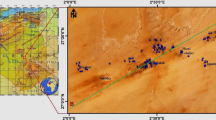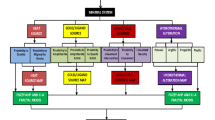Abstract
Geologically, Mahdishahr watershed are considered as a part of the folds of the Alborz southern slopes in which we can find the signs of the first to third geological periods. This basin with an area of 1954 km2 is located in the north of Semnan. About 600 springs are found in this area. In the present study, geostatistics and Boolean logic is used to evaluate the correlation between the springs location, discharge, and EC with structural factors and geological formations. In order to assess the role of geological formations in quality and quantity of the springs discharge, after preparing a file of the springs location with 500, 1000, 2000, and 5000 m buffers, effective pre-Quaternary formations were counted based on the Boolean logic and geostatistical methods. The results of this study showed that most springs have been occurred in Shemshak, Elika, marl, and Eocene limestone (Elm) formations, respectively, which are followed by Laar, Ruteh, and Barut limestone formations. The most faults and fractures in this area have been occurred in the same formations, with the amount of 176, 98, 77, 71, 58, and 38 km, respectively. The highest discharge among the formations was devoted to Tizkuh formation, with an ultra-low EC value, while the highest EC value was observed in marl, and Eocene limestone formations. So, it can be concluded that faults and fractures of this area are closely related to the number of exposed springs, so that the faults of this area have increased the number of the springs and the type of the formation has controlled the amount of the springs discharge.












Similar content being viewed by others
Notes
Electrical conductivity
References
Abdalla F (2012) Mapping of groundwater prospective zones using remote sensing and GIS techniques: a case study from the central Eastern Desert, Egypt. J Afr Earth Sci 70(27):8–17
Abshirini A, Rangzan K, khorshidi S (2008) Potential mapping of groundwater resources using index overlay method in GIS environment (a case study in Pabdeh anticline). Geomatics conference
Amiri MJ, Salman Mahini A, Jalali SG, Hosseini SM, Azeri Dehkordi F (2009) Comparison of the systemic integrated maping and combination of fuzzy and Boolean logic in evaluation of the ecological potential of Iran north forest 33 and 34 watershed. J Environ Sci 7(2):123–109
Bahrami SH, Zanganah Asadi MA, Rahbar H (2013) Evaluation of the role of geomorphology in hydrological and chemical characteristics of Kangir watershed. Journal of geography and urban-regional. Planning 7:71–84
Behniyafar A (2009) Geomorphical characteristics of Akhlmd karst in the northern slopes of the Binalood Mountains. J Geogr Dev 14:140–121
Behniyafar A, Sepehr A, Mansoori MR (2012) Kalat Mountain geomorphotourism: study on the correlation between the springs and geological formations. J Geogr Environ Plan 23(14):79–90
Behzoda A, Hamzeh F (2009) Study on the effect of geological formations on water quality in western Dehdasht aquifer. Q J Geogr 11:93–112
Boole G (1854) An investigation of the laws of thought: on which are founded the mathematical theories of logic and probabilities. Dover Publications
Darvari Z, Gholami V, Jokar sarhangi A (2011) Karst springs discharge simulation using artificial neural network (case study: central Alborz Mountains). J Phys Geogr Res 77:68–57
Faryabi M, Kalantari N, Negarestani A (2010) Evaluation of the factors affecting the chemical quality of Jiroft plain groundwater using statistical and hydrochemical methods. J Earth Sci 20(7):115–120
Geological Survey of Iran, Geological maps at a scale of 1: 250,000, Sari and Semnan Sheet 2018
Ghasemi A, Zareh Abyaneh H, Shahsavar AM, Yaghoubi Kikleh B (2010) Study on the quantitative and qualitative changes of Hamedan plain groundwater–Bahar. J Plants Ecosyst:109–127
Ghomshiyoun M, Malekiyan A, Hosseini KH, Gharechelou S, Khamushi MR (2012) A survey on spatial variations of gr oundwater quality in Semnan/Sorkheh plain using geostatistical techniques. J Iran Range Desert Res 19(3):535–545
Gopalan CV (2011) A comparative study of the groundwater potential in hard rock areas of Rajapuram and Balal, Kasaragod. Kerala, J Ind Geophys Union 15(3):179–186
Kalaantari N, Keshavarzi MR, Cherchi A (2009) Factors affecting the advent of Izeh plain spring basins. J Appl Geol 5(2):135–147
Kalaantari N, Khoubyri A, Dorrani Nejad MS (2012) Study on the role of fractures in Chamasiyab spring discharge in Khouzestan north east. J Appl Geol 8(1):65–72
Kazemi R, Ghayoomiyan J, Jalali N (2006) Study on the role of structural factors in frequency of water resources in Lar karst areas using remote sensing and GIS. Journal of research and development of natural. Resources 73:33–41
Kumar U, Kumar B, Mallick N (2013) Groundwater prospects zonation based on RS and GIS using fuzzy algebra in Khoh River watershed, Pauri-Garhwal District, Uttarakhand, India. Glob Perspect Geogr 1(3):37–45
Lotfi S, Habibi K, Meshkini A, Koohsari MJ (2008) New Multicritera approach for urban facility management by applying GIS. World Appl Sci J 3(1):56–59
Madi K, Zhao B (2013) Neotectonic belts, remote sensing and groundwater potentials in the eastern Cape Province, South Africa. Int J Water Resour Environ Eng 5(6):332–350
Maroufi S, Mahmoudi M, Solaymani S, Jafari B (2011) Assessment of flood spreading using index overlay maps and Boolean and fuzzy logic in GIS (case study: Poshtkuh watershed). J Soil Water Sci 21(4):1–16
Mohammadi Ghalani M, Ebrahimi K, Araghinejad SH (2011) Qualitative and quantitative assessment of groundwater resources (case study: Saveh and arak aquifers). J Soil Water Sci 21(2):93–108
Nazari AS, Kouhsari MJ (2007) Combining Boolean logic and analytical hierarchy process (AHP) using GIS. J Shahrngar 7(40):11–21
Rahnama H, Ghanbarpoor MR, Habibnejad Roshan M, Dadresi Sabzevar A (2012) Evaluation of the quantity and quality of groundwater resources (Jovin plain, Razavi Khorasan province). Journal of geography and urban-regional. Planning 2(3):31–46
Roux P, Preez CC, Strydo MG (2007) Significance of soil modifiers in naturally degraded vertisols of the peninsular Indian in redefining the sodic soils. Geoderma J 136(1–2):210–228
Saberi A, Rangzan K, Mahjouri R, Keshavarzi MR (2012) Finding potential groundwater resources by combining remote sensing and GIS in the analytic hierarchy process (AHP) in Khuzestan Kamestan anticline. J Adv Appl Geol 6:11–20
Travaglia (1988) Ground water exploration by satellite remote sensing on the Syrian Arab Republic. RSC services 76. FAO
Acknowledgments
The authors are greatly thankful to Semnan regional water authority for providing statistics on Mahdishar springs.
Author information
Authors and Affiliations
Corresponding author
Rights and permissions
About this article
Cite this article
Ardakani, A.H.H., Shojaei, S., Ekhtesasi, M.R. et al. Evaluation of the quantitative and qualitative relationship between springs and geological formations using geostatistics as well as Boolean logic in Iran. Arab J Geosci 11, 377 (2018). https://doi.org/10.1007/s12517-018-3718-9
Received:
Accepted:
Published:
DOI: https://doi.org/10.1007/s12517-018-3718-9




